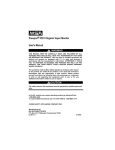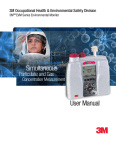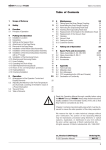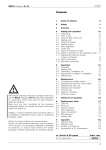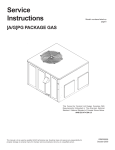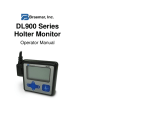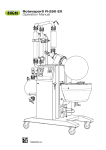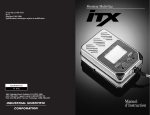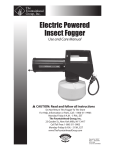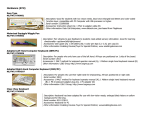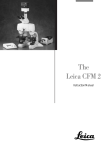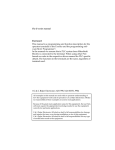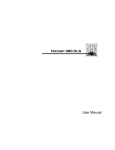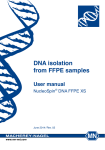Download Instruction Manual - Industrial Scientific
Transcript
PHOTOIONIZATION DETECTOR Instruction Manual OUR MISSION Design - Manufacture - Sell: Highest quality products for the preservation of life and property. Provide: Best customer service available. Dear Valued Customer, Thank you for buying and using Industrial Scientific’s VX500 PhotoIonization Detector. Your VX500 can be relied upon for dependable service, day after day. It has been designed, manufactured, tested and proven under the most scrutinizing conditions possible. With the minimal care and maintenance described in this Instruction Manual, it will provide you with years of reliable monitoring. I am most concerned that you be pleased with the performance of your VX500 in the months and years ahead. I urge you to call us with any questions or comments you may have. Often times a phone call and a question can save you hours of frustration. Please never hesitate to contact me at 1-800-DETECTS (338-3287). All of us at Industrial Scientific appreciate the opportunity to serve you. Sincerely, Kent D. McElhattan President & CEO Industrial Scientific Corporation PHOTOIONIZATION DETECTOR 2 TABLE OF CONTENTS WARNINGS AND CAUTIONARY STATEMENTS INTRODUCTION THEORY OF OPERATION UNPACKING THE INSTRUMENT INSTRUMENT OPERATION Turning the VX500 On and Off VX500 Gas Reading Mode CONFIGURATION ICONS VIEWING THE VX500 OPERATING MODES Changing Gas Type User Identification Site Identification Zeroing and Calibration Peak Readings Snapshot Mode TWA/STEL Readings Tick Mode Datalogging Session Indicator Datalog Session Pause Reset Datalog Session Clear Datalogging Memory CALIBRATING THE VX500 CONFIGURING THE VX500’S CUSTOM SETTINGS Security Code Change Security Code Change Gas Data Edit Favorite Response Factors List Using the Response Factors List Edit User Identification List Edit Site Identification List Allow Viewing of Peak Reading in the Field STEL/TWA Configuration Allow Viewing of Ticks Screen in the Field Select Backlight Mode Allow Viewing of Site and User in Field Allow Selection of Gas in Field Change Alarm Options Edit Time and Date Datalog Configuration Calibration Configuration MAINTENANCE Charging the Batteries Changing the Internal Filter Cleaning and Replacing the PID Lamp Lamp Removal Lamp Cleaning Procedure SPECIFICATIONS IONIZATION POTENTIALS FOR COMMON INDUSTRIAL GASES VX500 RESPONSE FACTORS LIST EXPLODED VIEW & REPLACEMENT PARTS VX500 REPLACEMENT PARTS LIST WARRANTY ATEX DECLARATION 3 4 4 6 8 8 9 9 10 10 10 11 11 11 12 12 12 13 13 13 13 14 15 15 16 16 16 16 17 17 18 18 18 19 19 19 19 20 20 21 22 22 22 23 24 24 26 27 32 35 39 41 43 WARNINGS AND CAUTIONARY STATEMENTS Failure to perform certain procedures or note certain conditions may impair the performance of the instrument. For maximum safety and performance, please read and follow the procedures and conditions outlined below. ! Recharge battery only in a non-hazardous location. ! Instrument tested for intrinsic safety in explosive gas/air (21.% oxygen) mixtures only. ! UV lamp requires periodic cleaning to function properly. The frequency of cleaning is dependent upon the environment in which the VX500 is used. Industrial Scientific recommends cleaning the UV lamp after every 40 hours of use. ! Any new or freshly cleaned 10.6 eV lamp requires a burn-in period of 24 hours in order for the lamp’s output to stabilize. This is done by placing the lamp into the lamp conditioner found on the charger/datalink accessory. ! Always check the ionization potential of the target gas prior to sampling to ensure proper lamp selection. For example, a 10.6 eV lamp can only detect gases with an ionization potential below 10.6 eV. ! The presence of water vapor in the sample stream can cause quenching of the detector signal due to UV absorption. Oxygen and methane are UV absorbers. Significant changes in their concentration can cause a change in the PID signal. ! Ammonia gas causes degradation of the VX500 PID module’s performance. ! Ethylene gas does not provide a consistent signal therefore the VX500 should not be relied upon to provide consistent readings when monitoring ethylene. ! A 5 minute warm-up time is required for VOC readings to fully stabilize after power-up of the VX500. ! EC TYPE EXAMINATION CERTIFICATE IS DEMKO 02ATEX 0228447X, WITH MARKING CODE EEx ia IIC T4, FOR EQUIPMENT GROUP AND CATEGORY II 1 G. ! WARNING: SUBSTITUTION OF COMPONENTS MAY IMPAIR INTRINSIC SAFETY AND MAY CAUSE AN UNSAFE CONDITION. ! CAUTION: FOR SAFETY REASONS, THIS EQUIPMENT MUST BE OPERATED AND SERVICED BY QUALIFIED PERSONNEL ONLY. READ AND UNDERSTAND MANUAL COMPLETELY BEFORE OPERATING OR SERVICING. Model VX500 must only be used with battery pack P/N 1708-9376 or 1708-8618EC 3 INTRODUCTION PhotoIonization detectors (PIDs) are a proven and reliable means of detecting volatile organic compounds (VOCs) in a variety of applications. Although the PID in general is not capable of distinguishing one gas species from another, it is a useful tool for detecting potentially hazardous gas vapors such as benzene, toluene, xylene and hundreds of other compounds at parts per million (ppm) or sub-ppm levels. The low resolution of the PID makes this instrument ideal for detecting traces of hydrocarbon gases in confined spaces, hazardous materials sites, areas under arson investigation, locations prone to releasing fugitive emissions or in environments where prolonged gas exposures may present a threat to workers’ health and safety. When used within the guidelines set forth in this manual the VX500 PhotoIonization Detector can be relied on to provide years of dependable service. These instructions will guide you through the set-up, operation, maintenance and calibration necessary for you to be assured that your VX500 is operating properly. THEORY OF OPERATION 4 The VX500 PhotoIonization Detector operates on the principle of absorption of ultraviolet light energy by a target gas. The internal sampling pump of the VX500 draws a gas stream into the instrument’s ionization chamber. This chamber holds an ultraviolet light source with a known energy potential. This potential is referred to as the photon energy of the lamp. If the energy from the lamp is at a level greater than the amount of energy required to excite the gas (the ionization potential) it will cause it to ionize, or release electrons. These electrons gather on the electrodes within the PID module and the instrument’s electronics interpret them as a quantitative concentration of gas. The number of electrons released is proportional to the concentration of the gas in the chamber. For example: A PID with an energy source or lamp with a 10.6 electron-volt (eV) photon energy is capable of detecting any compound which has an ionization potential less than or equal to 10.6 eV. Once the gas exits the ionization chamber it reclaims its lost electrons, returns to its original state and is returned to the atmosphere. Gas Out (No Longer Ionized) Display Amplifier UV Lamp’s Photon Energy is expressed in eV or Electron Volts 100 PPM UV Lamp Gas In Electrode Electrode Gas Out (No Longer Ionized) Graphic representation of PID theory of operation 5 UNPACKING THE INSTRUMENT The shipping box should contain the following items. Account for each item before discarding the box. QUANTITY PART NUMBER DESCRIPTION 1 18104034 VX500 PID Monitor 1 17098773 VX500 Instruction Manual 1 17095746 Maintenance Tool 1 17104407 Start-Up Card 1 18104364 Nylon Carrying Case 1 17065970 Urethane Tubing for Calibration After unpacking, if any listed item is missing, contact either your local distributor of Industrial Scientific products, or call Industrial Scientific Corporation at 1-800-DETECTS (338-3287) in the United States and Canada, or 412-788-4353. External Alarm Socket i-Button® Contact BOTTOM 6 FRONT Visual Alarm Gas Inlet Light Sensor for Display Backlighting PHOTOIONIZATION DETECTOR Display PPM VOC Up or “+” On/ Off Mode ON/OFF MODE ENTER Enter/ backlight BACK Down or “-” Gas Sample Audible Alarm Overflow Lamp Cover Charger/ Datalink Port Ionized Sample Output Battery Cover 7 INSTRUMENT OPERATION TURNING THE VX500 ON AND OFF To turn the VX500 on, press and hold on the unit’s membrane keypad until the instrument emits a short beep and the VX500 welcome screen appears on the instrument display. The current revision of instrument operating software is shown below the instrument model name. Pressing while this screen is shown will rotate the display 180 degrees to make viewing easier in applications where the VX500 may be hung upside-down. ON/OFF MODE Rev1.0 E To Rotate 180 ENTER ISOBUTYLENE Ratio = 1.00 Cal 100ppm Low 100ppm High 200ppm STEL 300ppm TWA 8H 1000ppm 9 After the welcome screen, the VX500 configuration screen will be displayed. This screen shows all parameters currently set in the instrument including the calibration gas concentration and all current alarm level settings. Following the configuration screen, the instrument will display a brief countdown timer while the VX500 completes the automatic warm-up cycle. During this countdown, if and are pressed simultaneously, the VX500 will enter into the configuration mode giving you the opportunity to change the instrument’s custom settings. If no keys are pressed during warm-up, the display will time out and begin detecting gas in the normal operation mode. To turn the VX500 off, press and hold at any time during operation until the instrument display shows RELEASE. After releasing the instrument’s display will blank and all instrument operation will cease. ON/OFF MODE ON/OFF MODE 8 VX500 GAS READING MODE Once the VX500 enters the Gas Reading Mode the instrument display will show the concentration of gas currently being detected along with the corresponding gas type. For general VOC detection this gas type will be isobutylene. You may select another gas in the configuration mode by editing the “favorites” list (see page 16). Gases selected from the favorites list will use response factors to determine actual gas concentrations. These response factors are referenced to isobutylene unless the VX500 is directly calibrated to the specific gas. R 0.1ppm Direct Cal ISOBUTYLENE If the monitored concentration of gas exceeds a preset limit for low alarm, high alarm, STEL, or TWA the VX500 will alert you by sounding an audible tone in conjunction with flashing an ultra bright red LED. Alarm conditions are also activated whenever a sensor fails calibration, the pump fails or becomes blocked, or the battery power is too low to operate the VX500. CONFIGURATION ICONS The top line of the instrument display will show a series of icons which identify the instrument’s current operating configuration. These icons are identified below and are explained in greater detail in later sections of this manual. Datalogging On Battery Type and charge status (Shading indicates charge status) R = rechargeable A = alkaline Tick Mode Snapshot Mode 9 VIEWING THE VX500 OPERATING MODES CHANGING GAS TYPE: ON/OFF MODE If changing gas type in the field is enabled, pressing one time during the normal operating screen will advance the instrument into the change gas type screen. This operating mode allows the user to select a response factor from either the Favorites List or the entire list of preprogrammed response factors. Using the arrow keys, scroll until the desired gas type is highlighted. Once highlighted, press the enter key. The instrument will enter into a gas set up screen where the calibration gas and alarm set points can be changed. Use the arrow keys to scroll to the desire field to be modified. Once highlighted, press to highlight the value. Using the arrow keys increase or decrease the value until desired setting is reached. Press to accept the new value. Once all changes are made, press to enter the gas readings screen. The display will now show the new response factor that the VX500 is set to. For a complete list of available response factors, refer to the table on page XX. ENTER ENTER ON/OFF MODE USER ID: User ID Mike Labans E To Change M To Continue ▼ scan iButton Press until "User ID" appears. The display will show the current user id that is entered into the instrument. If "Change Site and User ID in the Field" is enabled in the configuration, pressing enter will allow you to change to current user. If enter is pressed, the VX500 will look for the presence of an iButton on the iButton contact. If an iButton is detected, the user information will automatically be loaded into the instrument. If no iButton is detected, the user is prompted to select a user from the user id list, or manually enter the user name using the arrow keys and . ON/OFF MODE ENTER 10 SITE ID: Press until "Site ID" appears. The display will show the current site id that is entered into the instrument. If "Change Site and User ID in the Field" is enabled in the VX500 configuration modes, pressing enter will allow you to change to current site. If enter is pressed, the VX500 will look for the presence of an iButton on the iButton contact. If an iButton is detected, the site information will automatically be loaded into the instrument. If no iButton is detected, the user is prompted to select a site from the site id list, or manually enter the site name using the arrow keys and . ON/OFF MODE Site ID Vessel 63 E To Change M To Continue ▼ scan iButton ENTER ZEROING AND CALIBRATION: If field calibration is enabled in the set up menus, press until the Calibration Screen is reached. This screen shows you the last/next time calibration has occurred/is to occur. Pressing will enter the instrument into the zeroing sequence. Once zeroing is complete, pressing the key will allow the user to perform a calibration. (see Calibrating the VX500). If no buttons are pressed after the zeroing sequence, the instrument will return to normal operation. ON/OFF MODE ENTER ENTER Next Cal Date 06/26/2003 Calibrate Instrument? Press E To Zero Press M To Skip ZEROING PEAK READINGS: If the Peak Hold feature is enabled, press until "Peak" appears. The peaking reading displayed represents the highest VOC concentration measured since the peak reading was last cleared. In the instrument configuration menus, if clearing peaks in the field is enabled, pressing the key will clear the peaks. If this mode is not enabled, the peaks will not be able to be cleared. ON/OFF MODE ENTER R Peak 0.0ppm ISOBUTYLENE Press E To Clear 11 SNAPSHOT MODE: R If the Snapshot mode is enabled, press until the Snapshot menu screen appears. The Snapshot operating mode allows the user to capture the current instrument reading and store it in the datalogging memory along with the current time and date stamp. Pressing at any time while this mode is displayed will automatically result in the reading, time and date to be recorded into the instrument memory. When datalogging is turned off, the snapshot mode can be enabled. For more information on setting up the snapshot mode, refer to the Datalog Configuration section on page 20. ON/OFF MODE 0ppm 0 ppm 0 ppm E To Update ENTER TWA/STEL READINGS TWA 0 0 STEL E to reset both M to Continue If the STEL and TWA features are enabled, press until the TWA/STEL screen appears. This screen will display the current 8-hour time weighted average (TWA) and 15 minute short term exposure limit (STEL) average readings measured since these readings were last cleared and reset. Pressing while in this mode will reset the current TWA and STEL readings to zero. Resetting the STEL and TWA readings will automatically create a new datalogging session if the VX500’s datalogging feature is enabled. ON/OFF MODE ENTER TICK MODE R 0.1ppm ▲ & ▼ to Change Tick Rate E to Accept 12 If the Tick mode feature is enabled, press until the tick screen appears. With the tick mode enabled the VX500 will sound an audilble tick which increases in rate as the gas concentration detected is increased. This function may be useful in tracking leaking gas concentrations or while detecting fugitive emissions. ON/OFF MODE DATALOGGING SESSION INDICATOR 6/20/2002 If the Datalogging feature is enabled press until the “Datalog Session” screen appears. The datalogging session indicator displays the elapsed time that has passed since the datalogging session was last reset along with the current date and time. At one minute recording intervals the VX500 is capable of storing up to 150 hours of gas readings. ON/OFF MODE 08:22 +25.3 C Datalog Session Elapsed Time 00:01 DATALOG SESSION PAUSE If the Datalogging Pause feature is enabled, press until the “Datalog Session Enabled/Paused” screen appears. Pressing during this mode will toggle the datalogger from paused to enabled, allowing the user to control when the VX500 is datalogging. When paused, the datalogging icon flashes. ON/OFF MODE ENTER Datalog Session > Enabled E To Change RESET DATALOGGING SESSION If the Datalogging feature is enabled, press until the “Reset Datalog Session” screen appears. Pressing during the mode will start a new datalogging session and reset the elapsed session timer to 00:00. Pressing one time from the datalogging session indicator will return the instrument to the normal operating screen. ON/OFF MODE ENTER ON/OFF MODE Datalog Session Press E To Reset CLEAR DATALOGGING MEMORY: ON/OFF MODE If the Clear Datalogging feature is enabled, press until "Clear All Data" appears. Pressing the during this mode will clear all of the current datalogging memory. Pressing will return the instrument to the normal operating screen. ENTER ON/OFF MODE 13 CALIBRATING THE VX500 ZERO COMPLETE Apply Cal Gas To Instrument Press E to Span Press M to Skip Instrument is Calibrating Calibration Complete 62 Span 14 Gas detection instruments are potential life saving devices. Recognizing this fact, Industrial Scientific Corporation recommends that a functional “bump” test be performed on every instrument prior to each days use. A functional test is defined as a brief exposure of the monitor to a concentration of gas(es) in excess of the lowest alarm setpoint for the sensor for the purpose of verifying sensor and alarm operation and is not intended to be a measure of the accuracy of the instrument. Industrial Scientific Corporation further recommends that a full instrument calibration be performed using a certified concentration(s) of Industrial Scientific branded calibration gas(es) monthly to ensure maximum accuracy. Use of calibration gases from manufacturers other than Industrial Scientific may void product warranties and limit liability claims against the manufacturer. If an instrument fails to operate properly following any functional “bump” test, a full instrument calibration should be performed prior to use. To calibrate the VX500 press in the Gas Reading mode once to advance to the calibration screen. Press to begin the zeroing process. During the zeroing process, the words “Zero in progress” appear on the display. When the zeroing process is complete, the instrument will display “Apply XXX PPM” of the gas selected to be monitored. If you wish to perform the span calibration, apply the calibration gas thru a demand flow regulator and press to begin calibration. The VX500 will automatically recognize the presence of the calibration gas and the instrument will be calibrated automatically when the sensor response to the calibration gas becomes stable. Upon completion of calibration the VX500 will display a full span value and calibration status. A full span value that is greater than 70% of the applied gas concentration is considered good. A full span value that falls between 70% and 50% of the applied gas value is considered marginal. ON/OFF MODE ENTER ENTER A full span value below 50% of the applied gas value will fail calibration. For marginal or failed calibration the PID lamp may need to be cleaned (refer to Cleaning and Replacing the PID Lamp). If a VX500 fails either zero or span functions, the VX500 notes this condition on the display and the unit will not operate until the condition is corrected. CONFIGURING THE VX500’S CUSTOM SETTINGS The VX500 has many user configurable options and features. These features may be accessed through the configuration software utility and a PC, or adjusted by pressing and simultaneously during the warm-up cycle when the count down timer is displayed. 9 Configuring your VX500 is very intuitive. Every option is highlighted on the display. In general: Pressing Pressing or ENTER will step you through the modes. selects a function or accepts (saves) a value. Pressing moves you backward in the configuration or steps you completely out of set up to the “Gas Reading Mode.” ON/OFF MODE SECURITY CODE Once the configuration mode has been entered, the instrument will prompt you to enter a three digit security code access code (if this feature is enabled). If the security code feature is activated on the VX500, no configuration changes can be made without entering the proper code. The security code is entered by using and to scroll through the values. When the desired security code is reached, press to accept the value. The VX500's display will step to the next availble configuration screen if the proper code has been entered. Enter Security Code Using ▲ & ▼ O OO E To Accept M to Exit ENTER 15 CHANGE SECURITY CODE Change Security Code E to configure ▲ for next menu ▼ for prev menu M to exit config The “Security Features” screen allows you to establish a security code to protect your custom configurations. The security code is a three digit number that once established cannot be bypassed unless entered correctly. It is important that you record your security code and keep it in a safe location in the event you need recall the number. CHANGE GAS DATA Change Gas Data E to configure ▲ for next menu ▼ for prev menu M to exit config The “Change Gas Data” screen allows you to edit gas specific setpoints such as calibration gas values and low, high, STEL, and TWA gas concentration alarm values. This screen also allows you to configure the gas range giving you control over whether your VX500 reads in tenths of a ppm or whole ppm’s. EDIT FAVORITE RESPONSE FACTORS LIST Edit Favorite Response Factors List E to configure ▲ for next menu ▼ for prev menu M to exit config The “Edit Favorites Response Factors List” screen allows you to add/subtract gases on your favorite list of response factors. Response factors allow you to accurately monitor a gas, other than the gas the VX500 was calibrated to. Response factors are preprogrammed into the VX500 and are created by comparing the PID module’s response to the target gas versus the previously used calibration gas. USING THE RESPONSE FACTORS LIST Once selected, the response factor will automatically do the math and reference the signal to the specific compound of choice. For example, if you calibrated your VX500 using isobutylene and you wish to accurately monitor benzene, you would press and in the Gas Reading Mode, then choose between the Favorites List or the list of 100 preprogrammed compounds until you highlight benzene. Pressing here would select benzene and automatically use the associated response factor. For a list of available compound specific response factors refer to page 32 of this manual. ENTER 16 EDIT USER IDENTIFICATION LIST The “Edit User Identification List” screen allows you to manually enter instrument user information with up to 16 alpha/numeric characters. This list can then be used to imprint the datalogger with the current user as selected in the User ID screen in the Gas Readings Mode. Edit User Identification List E to configure ▲ for next menu ▼ for prev menu M to exit config ENTER Press to modify the user ID. allows changes to be made to the user list while allows changes to the current user. When making changes to the user list, use the arrow keys to scroll through current users to select a name to delete. When prompted, pressing allows users to be added to the current user lists. User names can be added automatically via an iButton, or manually entered using the arrow keys to select letters and key to accept. A maximum of 5 users can be stored on the current user list. ENTER When making changes to the current user, the VX500 will initially look for an iButton. If an iButton is not detected on the iButton reader, the VX500 will allow a new user name to be manually entered using the arrow keys to select letters and key to accept, or by using the iButton. ENTER EDIT SITE IDENTIFICATION LIST The“Edit Site Identification List” screen allows you to manually enter instrument site (location) information with up to 16 alpha/numeric characters. This list can be used to imprint the datalogger with the current location as selected in the Site ID screen in the Gas Readings Mode. Edit Site Identification List E to configure ▲ for next menu ▼ for prev menu M to exit config ENTER Press to modify the site ID. allows changes to be made to the site list while allows changes to the current site. When making changes to the site list, use the arrow keys to scroll through current sites to select a site to delete. When prompted, pressing allows sites to be 17 added to the current site lists. Site names can be added automatically via an iButton, or manually entered using the arrow keys to select letters and key to accept. A maximum of 5 sites can be stored on the current site list. ENTER When making changes to the current Site, the VX500 will initially look for an iButton. If an iButton is not detected on the iButton reader, the VX500 will allow a new site name to be manually entered using the arrow keys to select letters and key to accept, or by using the iButton. ENTER ALLOW VIEWING OF PEAK READING IN THE FIELD Allow Viewing of Peak Reading in the Field E to Configure ▲ for next menu ▼ for prev menu M to exit config The “Allow Viewing of Peak Reading in the Field” screen gives you control over whether the peak (highest concentration of VOC’s monitored since the peaks were last reset) readings will be viewed by users in the field. Choosing “no” blocks this display for the Gas Readings Mode while “yes” permits it to be viewed. STEL/TWA CONFIGURATION: Allow Viewing of STEL/TWA in the Field E to Configure ▲ for next menu ▼ for prev menu M to exit config Pressing allows the STEL/TWA to be configured. This mode allows the user to have control over displaying and reseting the STEL (short term exposure limit: a 15 minute running average of VOC concentrations) and TWA (time weighted average: a user defined average, usually 8 hours, of VOC concentrations) values in the field. The arrow keys toggle between turning these modes on and off, while the key accept the changes. The TWA time base can be changed using the arrow keys to increase or decrease the time base value and using to accept the new value. ENTER ENTER ENTER Allow Viewing of Ticks Screen in the Field E to Change ▲ for next menu ▼ for prev menu M to exit config 18 ALLOW VIEWING OF TICKS SCREEN IN THE FIELD The “Allow Viewing of Ticks Screen in the Field” screen gives you control over whether the ticks mode screen will be viewed in the field. Choosing “no” in this situation blocks the user for having control over turning on or off the tick feature of the VX500. The ticks mode sounds an audible tick that increases in frequency as the concentration of VOC’s detected increases. This is a useful tool when using the VX500 to detect leaks. SELECT BACKLIGHT MODE The “Select Backlight Mode” screen allows you to control whether your display backlight will be manually or automatically activated. If you choose manual, your backlight will only activate whenever is pressed. Choosing automatic backlight control will activate the display backlight whenever ambient light conditions diminish. This is accomplished through the use of a light sensor located on the VX500’s faceplate. ENTER ALLOW VIEWING OF SITE AND USER IN FIELD The “Allow Viewing of Site and User in Field” screen gives you control over whether the Site and User ID screens will be viewed in the field. Select Backlight Mode E to Change ▲ for next menu ▼ for prev menu M to exit config Allow Viewing of Site and User in Field E to Change ▲ for next menu ▼ for prev menu M to exit config ALLOW SELECTION OF GAS IN FIELD The “Allow Selection of Gas in Field” screen gives you control over whether the user will be able to access the “Favorites Response Factors” list from the Gas Readings Mode. Using response factors is explained in the “Edit Favorite Response Factors List” section of this manual. Allow Selection of Gas in Field E to Configure ▲ for next menu ▼ for prev menu M to exit config CHANGE ALARM OPTIONS: The change alarm options menu allows control over muting the alarms and latching the alarms. The audible alarm on the VX500 can be turned on and off. Using the arrow keys to toggle this feature between "on" and "off". Change Alarm Options E to Configure ▲ for next menu ▼ for prev menu M to exit config 19 When the alarms are muted, a message will be displayed across the screen of the VX500 to alert the user that the alarms are off. The alarm latching option allows the VX500's alarms to be latching or non-latching. A latching alarm alarm is an alarm that once activated, is not automatically cleared when the gas concentration drops below the alarm setpoint. To clear a latching alarm you must press once the gas concentration drops below the alarm setpoint. ENTER EDIT TIME AND DATE Edit Time and Date E to Configure ▲ for next menu ▼ for prev menu M to exit config The “Edit Time and Date” screen allows you to set the current time and date in your VX500. Accurate setting of the time and date are important for datalogging and calibration records. Use the arrow keys to increase or decrease the values for the time and date. Once a desired value is reached, use to move to the next value to be changed. ENTER DATALOG CONFIGURATION Datalog Configuration E to Configure ▲ for next menu ▼ for prev menu M to exit config Datalog Active >Yes ▲ or ▼ change E to accept M to exit The “Datalog Configuration” screen gives you control over the operation of your datalogger. If you choose to make your datalogger inactive then the VX500 continues on with the custom configuration. If you choose to activate the datalogger, then a subloop appears giving you control over the following: • Datalog Interval: Allows you to control the amount of time (in seconds) the unit will accumulate data before averaging and writing it to the datalogger. The range is 1 to 300 seconds. • Allow Datalog Reset in Field: Allows you to reset a logging session in the field. • Allow Datalog Pause in Field: Allows you to pause/resume datalogging in the field. 20 • Allow Datalog Clear in Field: Allows you to purge logged data in the field. If datalogging is not activated, the VX500 can have the "log on alarm" feature activated or be put into the Snapshot mode. The log on alarm feature allows the VX500 to automatically start logging gas readings whenever the instrument goes into an alarm condition. This feature is useful in capturing data only when the VX500 is in alarm. The Snapshot operating mode allows the user to capture the current instrument reading and store it in the datalogging memory instantly along with the current time and date. Pressing at anytime while this mode is active will result in a reading, time and date to be recorded into the instrument's memory. ENTER CALIBRATION CONFIGURATION: The "Calibration Configuration" screen gives the user control over the calibration of the VX500. When entered, the following sub-menus are availble: • Allow Calibration in Field: The “Allow Calibration in Field” screen gives you control over whether the VX500 can be calibrated in the field Allow Calibration In Field E to Configure ▲ for next menu ▼ for prev menu M to exit config View Calibration Date In Field • Vielw Calibration Date in Field: The “View Calibration Date in Field” screen allows you to choose whether last or due calibration dates are able to be viewed in the field. E to Configure ▲ for next menu ▼ for prev menu M to exit config • Choose Next/Last Calibration Date: The “Choose Next/Last Calibration Date” screen allows you to choose whether your calibration dates are expressed as the last time the VX500 was calibrated or when the calibration is due. You have two options for this screen: last and next. Choose next/last Calibration Date E to Configure ▲ for next menu ▼ for prev menu M to exit config • Edit Interval of Calibration: The “Edit Interval of Calibration” screen activates if you chose to display the calibration date in field. This screen allows you to choose the duration. The range is from 0-365 days. 21 MAINTENANCE With just normal routine maintenance the VX500 can be depended upon to provide years of reliable service. The following guidelines should be followed when performing maintenance on the VX500. CHARGING THE BATTERIES The lithium-ion battery pack should be fully charged before using the VX500. To charge the battery pack, plug the flying lead from the VX500 battery charger into the socket on the back of the instrument. The VX500 battery pack will be fully charged within 5 hours. With a fully charged lithium-ion battery pack, the VX500 should function for up to 18 hours of continuous operation. As battery life decreases, the shaded area of the battery icon will also decrease. With a minimum of 15 minutes of battery life remaining the VX500 will emit a periodic beep alerting you to charge or replace the battery. DO NOT REPLACE OR CHARGE INSTRUMENT BATTERIES IN HAZARDOUS LOCATIONS! ! CAUTION A replaceable cell alkaline battery pack (7 hours run-time) is also available for use with the VX500. To remove the battery pack and replace the 3 AA battery cells, loosen the two screws from the battery cover on the back of the instrument. Remove the battery pack and replace the AA battery cells with fresh alkaline batteries. Replace the battery pack and battery cover in the same fashion. CHANGING THE INTERNAL FILTER 22 The VX500 sample inlet is protected by an internal dust filter/water stop. When this filter becomes obstructed the VX500 will display a PUMP FAULT condition and the alarm will sound continuously to indicate that inadequate sample flow is being delivered to the instrument. To replace the filter, unscrew the sample inlet housing from the top of the instrument. Remove the dust filter/water stop and replace it with a new, fresh one. During replacement, ensure that the filter is inserted with the clear end down. Replace and tighten the sample inlet fitting on the top end of the VX500. If the VX500 still shows PUMP FAULT, the filter is not properly seated, the inlet cap is not tight, or the pump has failed. CLEANING AND REPLACING THE PID LAMP The function of the PID’s detector is dependent upon exposure of the gas sample to UV light via a precision lamp. A critical component of this lamp is its wavelength filter, or window. This window is the portion of the lamp directly exposed to the gas sample, and is therefore potentially exposed to water vapor, dirt, debris and oil residues. Because this lamp is used as a UV light source, it is critical to understand that degradation of the lamp’s output will cause the detector to lose sensitivity, and in extreme cases can limit the range of the detector. In order to retain peak performance of the VX500 PID detector, it is vital that the unit’s UV lamp window remain free of dirt debris and oil residues. When the window is contaminated you must periodically remove these contaminants. Refer to Figure 1 detailing the lamp’s window. The first step to preventing or decreasing lamp window contamination is repetitive replacement of the VX500’s sampling filter (part number 17058157). Also be careful when storing a spare lamp to avoid finger contact with the window and do not attempt to clean the lamp with compressed air (unless air source is oil and contaminant free). It is virtually impossible to prevent all factors that obstruct or degrade the UV lamp’s window surface, therefore as a recommendation a 10.6 eV lamp should be cleaned after every 40 hours of use, at any time when readings are suspect, or if a calibration failure occurs. 23 Industrial Scientific Corporation recommends an abrasive lamp cleaning, which will restore the lamp’s window to a pristine condition. A lamp cleaning kit is available (part number 17090721). Because the output of a freshly cleaned lamp is not fully stable until after a 24 hour burnin, please use a VX500, or one of the built in lamp conditioners contained in an Industrial Scientific charger or Docking Station™ to burn-in the lamp. If the unit is calibrated with a freshly cleaned lamp, sensitivity of the detector will gradually decrease until the lamp’s output stabilizes. This should occur within 24 hours. LAMP REMOVAL To remove the lamp from the VX500, unthread the unit’s lamp cap (cap is a right hand thread). After removing the lamp cap, grasp the bulb’s tubing grip, and pull the lamp straight out of its compartment. Inspect the lamp’s window for dirt, debris or oil residue. DO NOT TOUCH THE LAMP’S WINDOW !!! LAMP CLEANING PROCEDURE To clean the lamp, grasp the lamp by its body, not its tubing grip. Place a grey abrasive pad from cleaning kit 17090721 on a flat surface. (The adhesive on the back of the gray abrasive pad may be exposed via removal of its protective covering to affix the pad if desired). Position the UV lamp on the abrasive surface of the pad so that the window is flat against the surface of the abrasive pad. Apply light pressure to the lamp. Turn the lamp and lift. Reseat the lamp in a fresh position on the pad, and repeat this process 10-12 times to fully clean the lamp. To remove any abrasive residue from the lamp, grasp the lamp by its body again. Please use the brown felt cleaning pad from cleaning kit 17090721 on a flat surface, exactly like the abrasive pad. The adhesive on the back of the 24 brown cleaning pad may also be exposed via removal of its protective covering to affix the pad also if desired. As with the abrasive pad, position the UV lamp on the felt surface of the pad and make sure it is flat. Apply light pressure to the lamp and turn. Lift the lamp from the pad and reseat in a fresh position. Repeat this process 5-6 times. The lamp should be burned-in for a 24 hour period after cleaning. The VX500 should then be recalibrated once the lamp is re-installed in the unit. During lamp installation, insure that the lamp is fully seated in the VX500. 25 SPECIFICATIONS SIZE: (Maximum dimensions including case filter extension): 10"L x 2.9"W x 1.9"H (253mm x 75mm x 50mm) CASE: EMI/RFI static resistant, nickel plated, composite case. WEIGHT: with Li-Ion rechargeable battery pack -26 oz. (737 g) with AA disposable cell battery pack -23.8 oz. (675.9 g) DISPLAY: 128 X 64 Graphic Dot-Matrix LCD with built-in backlighting for low light conditions. AUDIBLE ALARM OUTPUT: 90 dB typical @ 12 inches/ 1 foot. VISUAL ALARM: Two (2) Red Ultra-bright LED’s (Light Emitting Diodes) TEMPERATURE RANGE OF OPERATION: -10 deg. C to 40 deg. C (14 deg. F to 104 deg. F) HUMIDITY RANGE OF OPERATION: 15 to 90% Relative Humidity (noncondensing). CONTINUOUS NON-ALARM AT ROOM TEMPERATURE RUN TIME Fully charged Li-Ion battery, in good condition Three (3) fresh AA cell Alkaline batteries 18 hours 7 hours Maximum recommended power down storage time for fully charged Li-Ion before recharging < 50 days. SAMPLE PUMP GAS FLOW RATE 26 1.0 SCFH (.5 LPM) IONIZATION POTENTIALS FOR COMMON INDUSTRIAL GASES Many compounds not appearing in this list with an ionization potential of 10.6 eV or less may be detected. Other sources of ionization potential data: CRC Handbook of Chemistry and Physics NIOSH Pocket Guide to Chemical Hazards HYPERLINK http://webbook.nist.gov/ Chemical Name Acetaldehyde Acetone Acetylene Acrolein Allene Allyl Alcohol Allyl Chloride Aminoethanol 2-Amino Pyridine Ammonia Aniline Arsine Benzaldehyde Benzene Benzenethiol Bromobenzene 1-Bromobutane 2-Bromobutane 1-Bromobutanone 1-Bromo-2-Chloroethane Bromoethane Bromoethene Bromoform 1-Bromo-3-Hexanone Bromomethane Bromomethyl Ethyl Ether 1-Bromo-2-Methylpropane 2-Bromo-2-Methylpropane 1-Bromopentane 1-Bromopropane IP (eV) Chemical Name IP (eV) 10.22 9.69 11.40 10.13 9.83 9.63 10.05 9.87 8.00 10.18 7.70 9.89 9.53 9.24 8.33 8.98 10.13 9.98 9.54 10.63 10.28 9.80 10.48 9.26 10.53 10.08 10.09 9.89 10.10 10.18 2-Bromopropane 1-Bromo8propene 2-Bromopropene 3-Bromopropene 2-Bromothiophene o-Bromotoluene m-Bromotoluene p-Bromotoluene 1,3-Butadiene 2,3-Butadione n-Butanal s-Butanal n-Butanol s-Butanol t-Butanol 2-Butanone 1-Butene cis-2-Butene 3trans-2-Butene n-Butyl Acetate s-Butyl Acetate t-Butyl Acetate n-Butyl Alcohol n-Butylamine s-Butylamine t-butylamine n-Butylbenzene t-Butylbenzene Butyl Cellusolve n-Butyl Mercaptan 10.08 9.30 10.06 9.70 8.63 8.79 8.81 8.67 9.07 9.23 9.83 9.73 10.04 10.23 10.25 9.54 9.58 9.10 9.13 10.00 9.91 9.90 10.04 8.71 8.70 8.64 8.69 8.68 8.68 9.15 27 Chemical Name t-Butyl Mercaptan p-tert-Butyltoluene 1-Butyne 82-Butyne n-Butyraldehyde Carbon Disulfide Chlorobenzene 1-Chlorobutanone 1-Chloro-2,3-Epoxypropane Chloroethene 1-Chloro-2-Fluorobenzene 1-Chloro-3-Fluorobenzene cis-1-Chloro-2-Fluoroethene trans-1-Chloro-2-Fluoroethene o-Chloroiodobenzene Chloromethylethyl Ether Chloromethylmethyl Ether 3-Chloropropene 2-Chlorothiophene o-Chlorotoluene m-Chlorotoluene p-chlorotoluene o-Cresol m-Cresol p-Cresol Crotonaldehyde Cumene 3-Cyanopropene Cyclobutane Cyclohexane Cyclohexanol Cyclohexanone Cyclohexene Cyclo-Octatetraene Cyclopentadiene Cyclopentane Cyclopentanone Cyclopentene 28 IP (eV) 9.03 8.28 10.10 9.85 9.83 10.08 9.07 9.54 10.60 9.99 9.16 9.21 9.87 9.87 8.35 10.08 10.25 10.04 8.68 8.83 8.83 8.70 8.93 8.98 8.97 9.73 8.75 10.39 10.50 9.88 10.00 9.14 8.95 7.99 8.56 10.52 9.26 9.01 Chemical Name Cyclopropane 2-Decanone Dibromochloromethane 1,1-Dibromoethane Dibromomethane 1,2-Dibromopropane Dibutylamine 1,2-Dichlorobenzene cis-1,2-Dichloroethene trans-1,2-Dichloroethene 1,1-Dichloropropanone 2,3-Dichloropropene Dicyclopentadiene Diethoxymethane Diethylamine Diethylamino Ethanol Diethyl Ether Diethyl Ketone Diethyl Sulfide 1,2-Difluorobenzene 1,4-Difluorobenzene Difluoromethylbenzene Diiodomethane Diisobutyl Ketone Diisopropylamine 1,1-Dimethoxyethane Dimethoxymethane Dymethylamine Dimethylaniline 2,3-Dimethylbutadiene 2,2-Dimethylbutane 2,3-Dimethylbutane 2,2-Dimethylbutan-3-one 3,3-Dimethylbutanone 2,3-Dimethyl-2-Butene Dimethyl Disulfide Dimethyl Ether 3,5-Dimethyl-4-Heptanone IP (eV) 10.06 9.40 10.59 10.19 10.49 10.26 7.69 9.07 9.65 9.66 9.71 9.82 7.74 9.70 8.01 8.58 9.53 9.32 8.43 9.31 9.15 9.45 9.34 9.04 7.73 9.65 10.00 8.24 7.14 8.72 10.06 10.02 9.18 9.17 8.30 8.46 10.00 9.04 Chemical Name 1,1-Dimethylhydrazine 2,2-Dimethyl-3-Pentanone 2,2-Dimethylpropane Dimethyl Sulfide (DMS) Di-n-Propylamine Di-n-Propyl Disulfide Di-n-Propyl Ether Di-i-Propyl Ether Di-n-Propyl Sulfide Epichlorohydrin Ethanethiol (Ethyl Mercaptan) Ethanolamine Ethene (Ethylene) Ethyl Acetate Ethylamine Ethyl Amyl Ketone Ethylbenzene Ethyl Bromide Ethyl Butyl Ketone Ethyl Chloroacetate Ethyl Disulfide Ethyl Ethanoate Ethyl Ether Ethylene Dibromide Ethylene Oxide Ethyl Iodide Ethyl Isothiocyanate Ethyl Methyl Sulfide Ethyl Propanoate Ethyl Trichloroacetate mono-Fluorobenzene mono-Fluoroethene o-Fluorotoluene m-Fluorotoluene p-Fluorotoluene Furan n-Heptane 2-Heptanone IP (eV) 8.05 8.98 10.35 8.69 7.84 8.27 9.27 9.20 8.30 10.60 9.29 9.87 10.52 10.01 8.86 9.10 8.76 10.29 9.02 10.20 8.27 10.10 9.41 9.45 10.56 9.33 9.14 8.55 10.00 10.44 9.20 10.37 8.92 8.92 8.79 8.89 9.90 9.33 Chemical Name 4-Heptanone n-Hexane 2-Hexanone 1-Hexene Hydrogen Selenide Hydrogen Sulfide Hydrogen Telluride Iodobenzene 1-Iodobutane9.212-Iodobutane Iodoethane (Ethyl Iodide) Iodomethane (Methyl Iodide) 1-Iodo-2-Methylpropane 1-Iodopentane 1-Iodopropane 2-Iodopropane o-Iodotoluene m-Iodotoluene p-Iodotoluene Isoamyl Acetate Isoamyl Alcohol Isobutanol Isobutyl Acetate Isobutyl Alcohol Isobutylamine Isobutylbenzene Isobutylene Isobutyl Ethanoate Isobutyl Formate Isobutyl Mercaptan Isobutyl Methanoate Isobutyraldehyde Isopentane Isoprene Isopropyl Acetate Isopropyl Alcohol Isopropylamine Isopropylbenzene Isopropyl Ether IP (eV) 9.12 10.18 9.44 9.46 9.88 10.46 9.14 8.73 9.09 9.33 9.54 9.23 9.19 9.26 9.17 8.62 8.61 8.50 9.90 10.16 10.12 9.97 10.12 8.70 8.68 9.43 9.95 10.46 9.12 10.46 9.74 10.32 8.85 9.95 10.10 8.72 8.75 9.20 29 Chemical Name Isovaleraldehyde Ketene Mesitylene Mesityl Oxide Methyl Acetate Methylamine Methyl Bromide 2-Methyl-1,3-Butadiene 2-Methylbutanal 2-Methylbutane 2-Methyl-1-Butene 3-Methyl-1-Butene 3-Methyl-2-Butene Methyl n-Butyl Ketone Methyl Butyrate Methyl Chloroacetate Methylcyclohexane Methylcyclohexanol Methylcyclohexanone 4-Methylcyclohexene Methylcyclopropane Methyl Dichloroacetate Methyl Ethanoate Methyl Ethyl Ketone Methyl Ethyl Sulfide 2-Methyl Furan Methyl Iodide Methyl Isobutyl Ketone Methyl Isobutyrate Methyl Isopropyl Ketone Methyl Mercaptan Methyl Methacrylate 2-Methylpentane 3-Methylpentane 2-Methylpropanal 2-Methylpropane 2-Methylpropene Methyl n-Propyl Ketone 30 IP (eV) 9.71 9.61 8.40 9.08 10.27 8.97 10.54 8.85 9.71 10.31 9.12 9.51 8.67 9.34 10.07 10.35 9.85 9.80 9.05 8.91 9.52 10.44 10.27 9.53 8.55 8.39 9.54 9.28 9.98 9.32 9.44 9.70 10.12 10.08 9.74 10.56 9.23 9.39 Chemical Name IP (eV) Methyl Styrene 8.35 Napthalene 8.12 Nitric Oxide 9.27 Nitrobenzene 9.92 p-Nitrochlorobenzene 9.96 5-Nonanone 9.10 3-Octanone 9.19 4-Octanone 9.10 1-Octene 9.52 cis-1,3-Pentadiene 8.59 trans-1,3-Pentadiene 8.56 n-Pentanal 9.82 n-Pentane 10.34 2,4-Pentanedione 8.87 2-Pentanone 9.39 3-Pentanone 9.32 1-Pentene 9.50 Perfuoro-1-Heptene 10.48 n-Perfuoropropyl Iodide 10.36 n-Perfuoropropyl-Iodomethane 9.96 n-Perfuoropropyl-Methyl Ketone 10.58 Phenol 8.50 Phenyl Ether 8.09 Phenyl Isocyanate 8.77 Phosphine 9.96 Pinene 8.07 Propadiene 10.19 n-Propanal 9.95 1-Propanethiol (n-Propyl Mercaptan) 9.20 n-Propanol 10.51 Propanone 9.69 Propene 9.73 Prop-1-ene-2-ol 8.20 Prop-2-ene-1-ol 9.67 Propionaldehyde 9.98 n-Propyl Acetate 10.04 n-Propyl Alcohol 10.15 n-Propylamine 8.78 Chemical Name n-Propylbenzene Propylene Propylene Imine Propylene Oxide n-Propyl Ether n-Propyl Formate Propyne Pyridine Styrene Tetrachloroethylene (PCE) Tetrafluoroethene Tetrahydrofuran Thioethanol Thiomethanol Thiophene 1-Thiopropanol Toluene o-Toluidine Tribromoethene 1,1,1-Trichlorobutanone Trichloroethylene (TCE) Trichloromethyl Ethyl Ether Triethylamine IP (eV) 8.72 9.73 9.00 9.81 9.27 10.54 10.36 9.27 8.40 9.32 10.12 9.45 9.29 9.44 8.86 9.20 8.82 7.44 9.27 9.54 9.45 10.08 7.50 Chemical Name 1,2,4-Trifluorobenzene 1,3,5-Trifluorobenzene Trifluoroethene 1,1,1-Trifluoro-2-Iodoethane Trifluoroiodomethane Trifluoromethylbenzene Trifluoromethylcyclohexane Trimethylamine 2,2,4-Trimethyl Pentane 2,2,4-Trimethyl-3-Pentanone n-Valeraldehyde Vinyl Acetate Vinyl Bromide Vinyl Chloride 4-Vinylcyclohexene Vinyl Ethanoate Vinyl Fluoride Vinyl Methyl Ether o-Vinyl Toluene o-Xylene m-Xylene p-Xylene 2,4-Xylidine IP (eV) 9.37 9.32 10.14 10.10 10.40 9.68 10.46 7.82 9.86 8.82 9.82 9.19 9.80 10.00 8.93 9.19 10.37 8.93 8.20 8.56 8.56 8.45 7.65 31 VX500 RESPONSE FACTORS LIST The response factors listed below in italics were derived from experimental data and are considered accurate +/- 25%. All other response factors are theoretical and no accuracy is published. All response factors are for the 10.6 eV lamp. Whenever possible, calibrate to the same gas being monitored. Abbreviated Name 1,4-BUTANEDIOL 1,4-DIOXANE 124(CH3)C6H5 123(CH3)C6H5 12C2H2BR2 12CL2C6H6 135(CH3)C6H5 1-BUTANOL 1MTH02PROPOL 1-PROPANOL 1XACETATE 1XACRYLAC 1XACTOACETAT 1XBENZOATE 1XMTHACRYLAT 2-BUTANONE 2-METHYLFORMAMIDE 2MTHOXYETOH 2-PENTANONE 2-PICOLINE 2-PROPANOL 2XFORMAMIDE 2XMTACETAMID 3-PICOLINE 4HYD4MTH2PNT ACETALDEHYDE ACETONE ACETOPHENONE ALLYL ALCOHOL AMMONIA AMYL ACETATE BENZENE 32 Chemical Name 1,4-BUTANEDIOL 1,4-DIOXANE 1,2,4-TRIMETHYLBENZENE 1,2,3-TRIMETHYLBENZENE 1,2-DIBROMOETHANE 1,2-DICHLOROBENZENE 1,3,5-TRIMETHYLBENZENE 1-BUTANOL 1-METHOXY-2-PROPANOL 1-PROPANOL METHYLACETATE METHYLACRYLATE METHYLACETOACETATE METHYLBENZOATE METHYMETHACRYLATE 2-BUTANONE DIMETHYLFORMAMIDE 2-METHOXYETHANOL 2-PENTANONE 2-PICOLINE 2-PROPANOL N,N-DIMETHYLFORAMIDE N,N-DIMETHYLACETAMIDE 3-PICOLINE 4-HYDROXY-4-METHYL-2-PENTANONE ACETALDEHYDE ACETONE ACETOPHENONE ALLYL ALCOHOL AMMONIA AMYL ACETATE BENZENE Response Factor 37.20 1.48 0.43 0.49 2.03 0.50 0.34 4.09 1.85 4.91 6.44 3.40 1.30 0.93 1.57 0.90 0.81 2.22 0.87 0.72 5.53 0.81 0.66 0.92 0.73 5.14 1.24 0.59 2.92 12.80 1.92 0.55 Abbreviated Name BROMOMETHANE BUTADIENE BUTOXYETHANOL BUTYLACETATE C2CL4 (C2H5)C6H5 C2HCL3 C6H1003 CHLOROBENZEN CUMENE CYCLOHEXANE CYCLOHEXANON DECANE DIETHYLAMINE DIMETHOXMETH EPICHLOROHYDRIN ETHANOL ETHYGLYCOL ETHYLACETATE ETHYLENE ETHYLENE OXIDE G-BUTYROLACTONE H2S HEPTANE HEXANE HYDRAZINE IAMYLACETATE IPROPYLAMINE IPROPYLETHER ISOBUTANOL ISOBUTYLENE ISOOCTANE ISOPHORONE ISOPROPANOL JET A FUEL JET A 1 FUEL JP 5 & JP 8 Chemical Name BROMOMETHANE BUTADIENE BUTOXYETHANOL BUTYLACETATE TETRACHLOROETHYLENE ETHYLBENZENE TRICHLOROETHYLENE ETHYLACETOACETATE CHLOROBENZENE CUMENE CYCLOHEXANE CYCLOHEXANOE DECANE DIETHYLAMINE DIMETHOXYMETHANE EPICHLOROHYDRIN ETHANOL ETHYLENEGLYCOL ETHYLACETATE ETHYLENE ETHYLENE OXIDE GAMMA BUTYROLACTONE HYDROGEN SULFIDE HEPTANE HEXANE HYDRAZINE ISOAMYLACETATE ISOPROPYLAMINE ISOPROPYLETHER ISOBUTANOL ISOBUTYLENE ISOOCTANE ISOPHORONE ISOPROPANOL JET A FUEL JET A 1 FUEL JP 5 & JP 8 FUEL Response Factor 2.72 0.73 1.44 2.38 0.60 0.53 0.51 1.14 0.49 0.54 1.44 0.82 1.24 0.89 1.51 7.70 10.70 15.30 4.10 10.20 12.20 3.01 3.30 2.35 4.06 2.60 1.79 1.28 0.84 4.99 1.00 1.21 0.74 5.93 1.06 1.06 1.06 33 Abbreviated Name MEK MESITYLOXIDE MIBK MONOMETHYLAMINE MTBE MTHLBENZLALCOHOL M-XYLENE N-METHLPYROLIDONE OCTANE O-XYLENE PHENLETHLALCOHOL PHENOL PHOSPHINE PROPYLENE PROPYOX P-XYLENE PYRIDINE QUINOLINE STYRENE T-BUTYLAMINE T-CLC2H2CL TERTBUTLMERCAPTAN TERBUTYLALCOHOL THF THIOPHENE TOLUENE TURPENTINE VCH VINYL ACETATE VINYL CHLORIDE BENZENE TUBE 34 Chemical Name METHYL ETHYL KETONE MESITYLOXIDE METHYLISOBUTYLKETONE MONOMETHYLAMINE METHYLTERTIARYBUTYLETHER METHYL BENZYL ALCOHOL META-XYLENE N-METHYL PYRROLIDONE OCTANE ORTHO-XYLENE PHENYL ETHYL ALOCHOL PHENOL PHOSPHINE PROPYLENE PROPYLENE OXIDE PARA-XYLENE PYRIDINE QUINOLINE STYRENEMONOMER TERTIARBUTYLAMINE TRISDICHLOROETHENE TERT BUTYL MERCAPTAN TERTIARY BUTYL ALCOHOL TETRAHYDROFURAN THIOPHENE TOLUENE TURPENTINE PURE GUM SPIRITS VINYLCYCLOHEXONE VINYL ACETATE VINYL CHLORIDE BENZENE TUBE Response Factor 0.97 0.54 1.14 1.64 0.89 7.12 0.45 1.02 2.10 0.54 9.04 1.10 3.02 1.41 6.30 0.47 0.78 0.97 0.47 1.01 0.45 0.61 3.24 1.53 0.41 0.53 0.50 0.54 1.17 1.90 0.60 FIGURE 4 35 FIGURE 5 FIGURE 6 36 FIGURE 7 37 FIGURE 8 38 VX500 REPLACEMENT PARTS LIST NOTE: Refer to Figure 4, 5, 6, 7 And 8 for each Item number listed. ITEM 1 2 3 PART NO. 17090408 17058157 17098971 3 17098930 4 17051513 5 6 17089269 17098948 7 17052628 8 9 10 11 12 13 14 17089319 17089285 17087735 17092727 17089004 17049876 17115205 15 17089095 16 17 18 19 20 20 21 22 17050245 17099011 17091380 17098823 17088618 17089376 17089012 17098815 23 24 17089079 17099565 DESCRIPTION Filter Cap (Includes Item 2, Filter) Replacement Dust/Water Stop Filter Case Bottom, Basic (Includes Items 3 & 16 Must also order an Item 11 to re-use Items 8 - 10 in case bottom) Case Bottom, Complete (Includes Items 3 - 17) Fitting, Inlet, Swivel, 1/16" tube to 10-32 thread. (two required per VX500). O-ring Seal, Input/Output Connector Input/Output Connector (Includes Item 5) Mounting Screws I/O connector (two required per VX500) C-clip, i-Button® Contact Seal, i-Button®, Contact Contact, i-Button® Case Insulator, i-Button®, Contact Gasket, Instrument, Conductive Instrument Strap Case Screws, Long, VX500 (two required per VX500) Case Screws, Short, VX500 (four required per VX500) Barrier, PID Vent PID Seal/Barrier Kit UV Lamp, 10.6 eV Lamp Cap, Replacement, VX500 Battery Pack, Rechargeable, Lithium-Ion Battery Pack, Alkaline Replaceable Gasket, Battery Cover, Conductive Battery Cover, Replacement, VX500 (Includes Items 22 - 26) Battery Cover, Screw, VX500, Short Battery Cover Screw Compression Stop, Short 39 ITEM. 25 26 27 PART NO. 17089053 17099581 17050453 28 28 29 30 31 32 32 33 17082025 17094855 17091141 17095183 17095233 17097122 17097304 17098831 34 35 36 37 17086695 17094673 17084377 17051845 38 17098914 38 17098906 39 40 41 42 43 44 45 46 47 48 17088998 17084435 17028374 17029273 17050277 17058918 17097296 17057118 17057027 17083585 DESCRIPTION Battery Cover, Screw, VX500, Long Battery Cover Screw Compression Stop, Long Screw, Pump/Display and Main PC Board Mount (two each required for Pump/Display Mounting (two each required for Main PC Board Mounting) Main Board, VX500 with programmed EPROM Programmed EPROM for VX500 (Not Shown) Module, PID Detector PID Flow Control Valve Flow Control Mounting Bracket PM-7000, VX500 Sampling Pump PM-7000 Sampling Pump Repair Kit Tubing, VX500 Replacement Assembly (Not Shown - See Figure 8 for placement) Left Display Mounting Bracket Display Assembly Right Display Mounting Bracket Screws, PID Detector Mounting (two required per VX500) Case Top, Basic,VX500 (Includes Items 38 - 40, 44 & 45) Case Top, Complete,VX500 (Includes Items 38 - 48) Faceplate, VX500 Keypad, VX500 External/Vibrating Alarm Jack External Alarm Cap Plug O-ring Seal, External Alarm Jack Alarm Water Barrier Alarm Seal Alarm Alarm Retaining Clips (three required per VX500) Screws, Alarm Retaining (three required per VX500) MAINTENANCE ACCESSORIES: 17090721 Lamp Cleaning Kit ADDITIONAL ACCESSORIES: 17096348 ISC i-Button® memory device with card mount 18104729 ISC i-Button® programming kit with software, 120 VAC 18105080 ISC i-Button® programming kit with software, 230 VAC 40 WARRANTY Industrial Scientific Corporation portable gas monitoring instruments are warranted to be free from defects in material and workmanship for as long as the instrument is in service. The above warranty does not include sensors, battery packs, internal pumps or filters, all of which are warranted to be free from defects in material and workmanship for 18 months from the date of shipment, or 1 year from the date of first use, whichever occurs first, except where otherwise stated in writing in Industrial Scientific literature accompanying the product. All other Industrial Scientific products are warranted to be free from defects in material and workmanship for a period of 18 months from the date of shipment, 1 year from the date of first use, whichever occurs first, except where otherwise stated in writing in Industrial Scientific literature accompanying the product. LIMITATION OF LIABILITY INDUSTRIAL SCIENTIFIC MAKES NO OTHER WARRANTIES, EITHER EXPRESSED OR IMPLIED, INCLUDING BUT NOT LIMITED TO THE WARRANTIES OF MERCHANTABILITY OR FITNESS FOR PARTICULAR PURPOSE. SHOULD THE PRODUCT FAIL TO CONFORM TO THE ABOVE WARRANTY, BUYER’S ONLY REMEDY AND INDUSTRIAL SCIENTIFIC’S ONLY OBLIGATION SHALL BE, AT INDUSTRIAL SCIENTIFIC’S SOLE OPTION, REPLACEMENT OR REPAIR OF SUCH NON-CONFORMING GOODS OR REFUND OF THE ORIGINAL PURCHASE PRICE OF THE NON-CONFORMING GOODS. 41 IN NO EVENT WILL INDUSTRIAL SCIENTIFIC BE LIABLE FOR ANY OTHER SPECIAL, INCIDENTAL OR CONSEQUENTIAL DAMAGES, INCLUDING LOSS OF PROFIT OR LOSS OF USE, ARISING OUT OF THE SALE, MANUFACTURE OR USE OF ANY PRODUCTS SOLD HEREUNDER WHETHER SUCH CLAIM IS PLEADED IN CONTRACT OR IN TORT, INCLUDING STRICT LIABILITY IN TORT. It shall be an express condition to Industrial Scientific’s warranty that all products be carefully inspected for damage by Buyer upon receipt, be properly calibrated for Buyer’s particular use, and be used, repaired, and maintained in strict accordance with the instructions set forth in Industrial Scientific’s product literature. Repair or maintenance by non-qualified personnel will invalidate the warranty, as will the use of non-approved consumables or spare parts. As with any other sophisticated product, it is essential and a condition of Industrial Scientific’s warranty that all personnel using the products be fully acquainted with their use, capabilities and limitations as set forth in the applicable product literature. Buyer acknowledges that it alone has determined the intended purpose and suitability of the goods purchased. It is expressly agreed by the parties that any technical or other advice given by Industrial Scientific with respect to the use of the goods or services is given without charge and at Buyer’s risk; therefore, Industrial Scientific assumes no obligations or liability for the advice given or results obtained. 42 43 P/N 1709-8773 REV 3.0 Printed 0104 1,000 Specifications Subject to Change GUARANTEED. FOR LIFE. 1001 Oakdale Road, Oakdale, PA 15071-1500 (412) 788-4353 • Toll Free 1-800-DETECTS FAX 412-788-8353 • Service Dept. 1-888-788-4353 VX500 Manual (1709-8773) Addendum (Rev. 1) VOC Reference Chart for VX500 Software Version 4.2 When monitoring for volatile organic compounds (VOCs), end users are often looking for more specific technical data. The table below is a reference for common industrial VOCs. When the compound appears in the VX500’s response factor library, the response factor is listed. This list reflects the latest values programmed into the VX500, software version 4.2. 10.6 eV PID Response Factor Database Chemical name Acetaldehyde Acetaldehyde oxime Acetic acid Acetic Anhydride Acetone Acetophenone Acetylene Acrolein Acrylic Acid Acrylonitrile Allyl Alcohol Allyl Chloride Ammonia Amyl Acetate Amyl Alcohol Aniline Anisole Arsine Benzaldehyde Benzene Benzonitrile Benzyl Alcohol Benzyl Chloride Benzyl Formate Boron Trifluoride Bromine Bromobenzene 2-Bromoethyl methyl ether Bromoform Bromomethane Bromopropane, 11,3-butadiene 1,4-butanediol Synonym CAS # Formula IP, ev 75-07-0 C2H4O 10.23 Ethanoic acid Ethanoic acid Anhydride 2 - Propanone 64-19-7 108-24-7 67-64-1 C2H4O2 C2H40 C3H6O 10.66 10.14 9.71 Ethyne Propenal Propenoic Acid Propenenitril 74-86-2 107-02-8 79-10-7 107-13-1 107-18-6 107-05-1 7664-41-7 628-63-7 C2H2 C3H4O C3H4O2 C3H3N C3H6O C3H5CI H3N C7H14O2 11.4 10.1 10.6 10.91 9.67 9.9 10.16 <9.9 75-85-4 62-53-3 100-66-3 7784-42-1 100-52-7 71-43-2 100-47-0 100-51-6 C5H12O C7H7N C7H8O AsH3 C7H6O C6H6 C7H5N C7H80 10 7.72 8.21 9.89 9.49 9.25 9.62 8.26 100-44-7 C7H7CI 9.14 104-57-4 7637-07-2 7726-95-6 108-86-1 6482-24-2 C8H8O2 BF3 Br2 C6H5Br C3H7OBr 15.1 10.51 8.98 10 75-25-2 CHBr3 10.48 106-94-5 C3H7Br 10.18 9.07 3 - Chloropropene mix of n-Pentyl acetate & 2-Methylbutyl acetate 1 - Pentanol Aminobenzene Methoxybenzene Arsenic trihydride Cyanobenzene a-Hydroxytoluene, Hydroxymethylbenzene, Benzenemethanol a-Chlorotoluene, Chloromethylbenzene Fromic acid benzyl ester VX500 Response Factor 5.14 1.24 0.59 2.92 12.80 1.92 0.55 2.72 n - Propyl bromide 37.20 Butadiene Butadiene diepoxide, 1,3Butane 2-butanone Butanol, 1Butanol, t2-Butanone Butene, 1Butoxyethanol, 2Butyl acetate, nButyl acrylate, nButylamine, nButylamine, tButyl cellosolve Butyl hydroperoxide, tButyl mercaptan Butyrolactone Carbon disulfide Carbon tetrachloride Chlorine Dioxide Chloro -1,3- Butadiene, 2Chlorobenzene Chloro -1,1Difluoroethane Chlorodifluoromethane Chloroethane Chloroethanol Chloroethyl ether, 2Chloroethyl methyl ether, 2Chloroform Chloropicrin Chlorotoluene, oChlorotoluene, pCitral Crotonaldehyde Cumene Cyanogen bromide Cyanogen chloride Cyclohexane Cyclohexanol Cyclohexanone cyclohexene cyclohexylamine Cyclopentane Decalin Decane Diacetone alcohol Dibromochloromethane Dibromochloropropane Dibromoethane, 1,2Dibutyl amine Dichlorobenzene, oDichlorobenzene, mDichlorobenzene, pDichlorofluoromethane 1,3-Butadiene, Vinyl ethylene 1,2,3,4-Diepoxybutane 106-99-0 C4H6 0.73 298-18-0 106-97-8 C4H4O2 C4H10 10 10.53 Butyl alcohol, n-Butanol tert-Butanol, t-Buty alcohol 71-36-3 75-65-0 C4H10O C4H10O 9.99 9.9 1-Butylene Butyl Cellosolve, Ethylene glycol monobutyl ether 106-98-9 111-76-2 C4H8 C6H14O2 9.58 <10 1.44 123-86-4 141-32-2 C6H12O2 C7H1202 10 2.38 109-73-9 C4H11N 8.71 0.90 4.09 3.24 0.90 Butyl 2-propenoate, Acrylic acid butyl ester tert-butylamine see 2-Butoxyethanol 1-Butanethiol gama-butyrolctone 1.01 111-76-2 75-91-2 109-79-5 Chloroprene Monochlorobenzene (R-142B) 75-15-0 56-23-5 10049-044 126-99-8 108-90-7 75-68-3 HCFC-22, R-22 Ethyl chloride Ethylene chlrohydrin bis (2-chloroethyl) ether 75-45-6 75-00-3 107-07-3 111-44-4 Methyl 2-chloroethyl ether Trichloromethane 627-42-9 67-66-3 o-Chloromethylbenzene p-Chloromethylbenzene trans-2-Butenal Isopropylbenzene Tetrachloromethane C4H10O2 C4H10S <10 9.14 CS2 CCI4 CIO2 10.07 11.47 10.57 C4H4CI C6H5CI C2H3CIF 2 CHCIF2 C2H5CI C2H5CIO C4H8CI2 O C3H7CIO 9.06 12 .61 3.01 0.49 12.2 10.97 10.52 11.37 95-49-8 106-43-4 CHCI3 CCI3NO2 C7H7CI C7H7CI 123-73-9 98-82-8 506-68-3 506-77-4 110-82-7 108-93-0 108-94-1 110-83-8 108-91-8 287-92-3 C4H6O C9H12 CNBr CNCI C6H12 C6H12O C6H10O C6H10 C6H13N C5H10 9.73 8.73 11.84 12.34 9.86 9.75 9.14 8.95 8.62 10.33 124-18-5 123-42-2 C10H22 C6H12O2 9.65 9.65 124-48-1 CHBr2CI 10.59 EDB, Ethylene dibromide, Ethylene bromide 106-93-4 C2H4Br2 10.37 2.03 1,2-Dichlorobenzene 95-50-1 C6H4CI2 9.08 0.50 CFC-12 75-71-8 CCI2F2 11.75 Cyclohexyl alcohol 4-Methyl-4-hydroxy-2pentanone Chlorodibromomethane 8.83 8.69 0.54 1.44 0.82 1.24 0.73 Dichloroethane, 1,2Dichloroethene, 1,1Dichloroethene, c-1,2Dichloroethene, t-1,21,1-dichloroethylene Dichloro-1-fluoroethane, 1,1Dichloropentafluoropropa ne Dichloropropane, 1,2Dichloro-1-propene, 1,3Dichloro-1propene, 2,3Dichlorvos Dicyclopentadiene EDC, 1,2-DCA, Ethylene dichloride 1,1-DCE, Vinylidene chloride c-1,2-DCE, cis-Dichloroethylene t-1,2-DCE, tris-Dichloroethylene 107-06-2 C2H4CI2 11.04 75-35-4 C2H2CI2 9.79 156-59-2 C2H2CI2 9.66 156-60-5 C2H2CI2 9.65 R-141B 1717-006 442-56-0 C2H3CI2 F C3HCI2F 5 C3H6CI2 C3H4C12 C3H4CI2 C4H7CI2 O4P C10H12 AK-225, mix of ~45% 3,3- Vapona: O,O-dimethyl Odichlorovinyl phosphate DCPD, Cyclopentadiene dimer Diesel Fuel #1 Diesel Fuel #2 Diethylamine Diethylaminopropylamine, 3Diethylmaleate Diethyl sulfide Diisopropylamine Diketene Dimethoxymethane Dimethylacetamide, N,NDimethylamine Dimethyl carbonate Dimethyl disulfide Dimethylethylamine Dimethylformamide, N,NDimethylhydrazine, 1,1Dimethyl sulfate Dimethyl sulfoxide Dioxane, 1,4Dioxolane 1,3DS-108F Wipe Solvent Epichlorohydrin Ethane Ethanol Ethanolamine Ethene Ethoxyethanol, 2Ethyl acetate Ethylacetoacetate Ethyl acrylate Ethylamine Ethylbenzene Ethylene glycol Ethylene glycol dimethyl ether Ethylene oxide Ethyl ether Ethyl 3-ethoxypropionate Ethyl hexyl acrylate, 2Ethyl (S)-(-)- lactate Ethyl (S)-(-)- lactate Ethyl sulfide Formic acid 78-87-5 542-75-6 78-88-6 62-73-7 77-73-6 1.09 (11.7) 0.45 10.87 <10 <10 <9.4 6833430-5 6833430-5 109-89-7 104-78-9 m.w. 226 141-05-9 C8H12O4 108-18-9 674-82-8 C6H15N C4H4O2 7.73 9.6 127-19-5 124-40-3 616-38-6 C4H9NO C2H7N C3H6O3 8.81 8.23 10.5 624-92-0 598-56-1 68-12-2 57-14-7 77-78-1 67-68-5 123-91-1 646-06-0 97-64-3 106-89-8 C2H6S2 C4H11N C3H7NO C2H8N2 C2H6O4S C2H6OS C4H8O2 C3H6O2 m.w. 118 C2H5CIO 7.4 7.74 9.13 7.28 74-84-0 64-17-5 141-43-5 74-85-1 110-80-5 C2H6 C2H6O C2H7NO C2H4 C4H10O2 11.52 10.47 8.96 10.51 9.6 141-78-6 C4H8O2 C6H10O3 C5H8O2 C2H7N C8H10 C2H6O2 C4H10O2 10.01 C2H4O C4H10O C7H14O3 C11H20O 2 C5H10O3 C5H10O3 C4H10S CH2O2 10.57 9.51 m.w. 216 C4H11N C7H18N2 8.01 0.89 see Ethyl sulfide Ketene dimer DMA Carbonic acid dimethyl ester DMDS DMEA DMF UDMH DMSO, Methyl sulfoxide Ethylene glycol formal Ethyl lactate/Isopar H/ ECH Chloromethyloxirane, 1-chloro2,3-epoxypropane Ethyl alcohol MEA, Monoethanolamine Ethylene Ethyl cellosolve, Ethylene glycol monoethyl ether 1,2-Ethanediol 1,2-Dimethoxyethane, Monoglyme Oxirane, Epocyethane Deithyl ether EEP Acrylic acid 2-ethylhexyl ester Ethyl lactate, Ethyl (S)-(-)Ethyl lactate, Ethyl (S)-(-)Diethyl sulfide 140-88-5 75-04-7 100-41-4 107-21-1 110-71-4 75-21-8 60-29-7 763-69-9 103-11-7 687-47-8 687-47-8 352-93-2 64-18-6 1.51 0.66 .81 9.1 9.19 9.9 1.48 10.2 7.70 <10.3 8.86 8.77 10.16 9.2 10 8.43 10.70 10.20 4.10 1.14 0.53 15.30 12.20 Furfural Furfuryl alcohol Gasoline #1 Gasoline #2, 92 octane Glutaraldehyde Heptane, nHexamethyldisilazane, 1,1,1,3,3,3Hexane, nHexanol, 1Hexene, 1Hydrazine Hydrogen Hydrogen cyanide Hydrogen peroxide Hydrogen sulfide Iodine Iodomethane Isoamyl acetate Isobutane Isobutanol Isobutene Isobutyl acetate Isobutyl acrylate Isobutylene Isooctane Isopar E Solvent Isopar G Solvent Isopar K Solvent Isopar L Solvent Isopar M Solvent Isopentane Isophorone Isoprene Isopropanol Isopropylamine Isopropyl acetate Isopropyl ether Jet fuel JP-4 Jet fuel JP-5 &JP-8 Jet A Jet A1 fuel Limonene, DMesityl oxide Mesitylene Methane Methanol Methoxyethanol, 2Methoxyethoxyethanol, 2- 1- Methoxy-2-propanol Methyl acetate Methylacetoacetate Methyl acrylate Methylamine Methylbenzoate Mthyl benzyl alcohol 2- Furaldehyde 110-54-3 111-27-3 592-41-6 302-01-2 1333-74-0 74-90-8 7722-84-1 7783-06-4 7553-56-2 74-88-4 123-92-2 75-28-5 78-83-1 115-11-7 C5H4O2 C5H6O2 m.w. 72 m.w. 93 C5H8O2 C7H16 C6H19NS i2 C6H14 C6H14O C6H12 H4N2 H2 HCN H2O2 H2S I2 CH3I C7H14O2 C4H10 C4H10O C4H8 110-19-0 106-63-8 C6H12O2 C7H12O2 540-84-1 64741-668 64742-489 64742-489 64742-489 64742-478 78-78-4 78-59-1 78-79-5 67-63-0 C8H18 m.w. 121 108-21-4 108-20-3 8008-20-6 8008-20-6 C5H10O2 C6H14O m.w. 115 m.w. 167 8008-20-6 m.w. 165 ( R ) - (+) - Limonene 5989-27-5 C10H16 8.2 1,3,5-Trimethylbenzene Natural gas Methyl alcohol, carbinol Methyl cellosolve, Ethylene glycol monomethyl ether 2-(2-methoxyethoxy) ethanol Diethylene glycol monomethyl ether 108-67-8 74-82-8 67-56-1 109-86-4 C9H12 CH4 CH4O C3H8O2 8.41 12.61 10.85 10.1 2.22 111-77-3 C7H16O <10 3.64 107-98-2 79-20-9 C3H6O2 10.27 96-33-3 C4H6O2 9.9 74-89-5 CH5N 8.97 1,5-Pentanedial HMDS Hexyl alcohol Synthesis gas Hydrocyanic acid Methyl iodide Isopentyl acetate 2-Methylpropane 2-Methyl-1propanol Isobutylene, Methyl butene Isobutyl 2-propenoate, Acrylic acid Isobutyl ester 2,2,4-Trimethylpentane Isoparaffinic hydrocarbons Photocopier diluent Isoparaffinic hydrocarbons Isoparaffinic hydrocarbons Isoparaffinic hydrocarbons 2- Methylbutane 2-methyl-1,3-butadiene Isopropyl alcohol, 2propanol 98-01-1 98-00-0 8006-61-9 8006-61-9 111-30-8 142-82-5 999-97-3 9.21 <9.5 9.92 8.6 2.35 10.13 9.89 9.44 8.1 15.43 13.6 10.54 10.45 9.4 9.54 <10 10.57 10.02 9.24 4.06 9.86 2.60 3.30 1.79 4.99 1.00 1.21 m.w. 148 m.w. 156 m.w. 163 m.w. 191 C5H12 C9H14O C5H8 C3H8O 9.07 8.85 10.12 0.74 5.93 1.28 Diisopropyl ether Jet B, Turbo B, Jet 5, Kerosene type aviation fuel Jet A-1, Kerosene type 9.99 9.2 0.84 1.06 1.06 1.06 0.54 Methyl 2-propenoate, acrylic acid methyl ester Aminomethane 1.85 6.44 1.30 3.40 1.64 0.93 Methyl bromide Methyl t-butyl ether Methyl chloride Methylcyclohexane Methylene chloride Methyl ether Methyl ethyl ketone Methyl hydrazine Methyl isobutyl ketone Methyl isocyanate Methyl isothiocyanate Methyl mercaptan Methyl methacrylate Methyl nonafluorobutyl Methyl-1,5- pentanediamine, 2- (coats lamp) Methyl propyl ketone Meth-2-pyrrolidinone, N- Methyl salicylate Methylstyrene, aMethyl sulfide Mineral spirits Mineral Spirits - Viscor 120B Mustard Naphthalene Nickel carbonyl (in CO) Bromomethane MTBE, tert-Butyl methyl ether Chloromethane Dichlormethane Dimethyl ether MEK, 2-Butanone Monomthylhydrazine, Hydrazomethane MIBK, 4-Methyl-2pentanone CH3NCO CH3NCS Methanethiol HFE-7100DL Dytek-A amine, 2-Methyl pentamethylenediamine MPK, 2-Pentanone NMP, NMethylpyrrolidone, 1-Methyl-2-pyrrolidinone, 1-Methyl 2-pyrrolidone Methyl 2-hydroxybenzoate 2-Propenylbenzene DMS, Dimethyl sulfide Stoddard Solvent, Varsol 1 Calibration Fluid, b.p. 156207*C HD, Bis (2-chloroethyl) sulfide Mothballs Nickel tetracarbonyl Nitric oxide Nitrobenzene Nitrogen dioxide Nonane Octane, nPentane 2-Pentanone Peracetic/Acetic acid mix Perchloroethene PGME PGMEA Phenol phenylethylalcohol Phosgene in Nitrogen Phosphine Photocopier Toner Picoline, 2Picoline, 3Pinene, aPinene, bPiperylene, isomer mix Propane Propanol, n- 74-83-9 1634-04-4 CH3Br C5H12O 10.54 9.24 74-87-3 107-87-2 75-09-2 115-10-6 78-93-3 60-34-4 CH3CI C7H14 CH2CI2 C2H6O C4H8O C2H6N2 11.22 9.64 11.32 10.03 9.51 7.7 108-10-1 C6H12O 9.3 1.14 624-83-9 551-61-6 74-93-1 80-62-6 16370208-7 1552-10-2 C2H3NO C2H3NS CH4S C5H8O2 C5H3F9O 10.67 9.25 9.44 9.7 1.57 C6H16N2 <9 107-87-9 872-50-4 C5H12O C5H9NO 9.38 9.17 119-36-8 98-83-9 75-18-3 8020-83-5 8052-41-3 C8H8O3 C9H10 C2H6S m.w. 144 m.w. 142 9 8.18 8.69 505-60-2 C4H8CL2 S C10H8 C4NiO4 8.13 <8.8 NO 9.26 9.81 10102-440 111-84-2 111-65-9 109-66-0 C6H5NO 2 NO2 C9H20 C8H18 C5H12 9.72 9.82 10.35 79-21-0 C2H4O3 127-18-4 C2CI4 107-98-2 C6H12O3 108-65-6 C6H12O3 108-95-2 C6H6O 8.51 75-44-5 7803-51-2 CCI2O PH3 11.2 9.87 108-99-6 2437-95-8 18172-673 504-60-9 74-98-6 71-23-8 C6H7N C10H16 C10H16 9.04 8.07 8 C5H8 C3H8 C3H8O 8.6 10.95 10.22 91-20-3 13463-393 10102-439 98-95-3 2.72 .89 .97 0.87 1.02 9.75 2.10 0.87 Peroxyacetic acid, Acetyl hydroperoxide PCE, Perchloroethylene, Tetrachloroethylene Propylene glycol methyl ether, 1-Methoxy-2-propanol Propylene glycol methyl ether acetate 1-methoxy-2acetoxypropane, 1Methoxy-2-propanol acetate Hydroxybenzene Phenol Ethyl alcohol Dichlorocarbonyl Isoparaffin mix 2-Methylpyridine 3-Methylpyridine 1,3-Pentadiene Propyl alcohol 9.32 1.85 1.10 9.04 3.02 0.72 0.92 4.91 Propanol, 2Propene Propionaldehyde Propyl acetate, nPropylene carbonate Propylene glycol Propylene oxide Propyleneimine Propyl mercaptan, 2Pyridine Pyrrolidine (coats lamps) RR7300 (PGME/PGMEA) quinoline Sarin Styrene Sulfur dioxide Sulfur hexafluoride Sulfuryl fluoride Tabun Tetrachloroethane, 1,1,2,2Tetracholoethylene Tetraethyllead Tetraethyl orthosilicate Tetrafluoroethane, 1,1,1,2Tetrafluoroethylene Tetrafluoromethane Tetrahydrofuran Tetramethyl orthosilcate Therminol VP-1 Thiophene Toluene Tolylene-2,4-diisocyanate Trichlorobenzene, 1,2,4Trichloroethane, 1,1,1Trichloroethane, 1,1,2Trichloroethylene Trichlorotrifluoroethane, 1,1,2Triethylamine Triethyl borate Triethyl phosphate Trimethylamine Trimethylbenzene, 1,2,3 Trimethylbenzene, 1,2,4 Trimethylbenzene, 1,3,5 Trimethyl borate Trimethyl phosphate Trimethyl phosphite Turpentine Undecane Propyl alcohol Propylene Propanal 1,2-Propanediol Methyloxirane 2-Methylaziridine 2-Propanethiol, Isopropyl mercaptan Azacyclohexane 70:30 PGME:PGMEA (1Methoxy-2-propanol:1Methoxy-2acetoxypropane) 115-07-1 123-38-6 109-60-4 108-32-7 57-55-6 75-56-9 75-55-8 75-33-2 C3H8O C3H6 C3H6O C5H10O2 C4H6O3 C3H8O2 C3H6O C3H7N C3H8S 110-86-1 123-75-1 107-98-2 C5H5N C4H9N C4H10O2 / C6H12O3 107-44-8 C4H10FO 2P C8H8 SO2 SF6 SO2F2 C5H11N2 O2P 9.73 9.95 10.04 10.5 <10.2 10.22 9 9.15 9.25 8 5.53 1.41 6.30 0.78 0.97 GB, Isopropyl Vkane Ethyl N, Ndimethylphosphoramidocy anidate TEL Ethyl silicate, TEOS HFC-134A TFE, Tetrafluoroethylene, Perfluoroethylene CFC-14, Carbon tetrafluoride THF Methyl silicate, TMOS 100-42-5 7446-09-5 2551-62-4 2699-79-8 77-81-6 79-34-5 116-14-3 78-00-2 78-10-4 8.43 12.32 15.3 13 811-97-2 116-14-3 C2H2CI4 C2Cl4 C8H20Pb C8H20O4 Si C2H2F4 C2F4 75-73-0 CF4 >15.3 109-99-9 681-84-5 C4H8O C4H12O4 Si C12H10O 9.41 10 11.1 .60 11.1 9.8 10.12 Dowtherm, 3:1Diphenyl oxide: 101-84-8 Methylbenzene TDI, 4-Methyl-1,3phenylene2,4-diisocyanate 1,2,4-TBC 1,1,1-TCA, Methyl chloroform 1,1,2-TCA TCE, Trichoroethylene CFC-113 108-88-3 584-84-9 C7H8 C9H6N2 O2 8.82 120-82-1 71-55-6 C6H3CI3 C2H3CI3 9.04 11 79-00-5 79-01-6 76-13-1 C2H3CI3 C2HCI3 C2CI3F3 9.47 11.36 TEA TEB; Boric acid triethyl ester, Boron ethoxide Ethyl phosphate 121-44-8 150-46-9 C6H15N C6H15O3 B 7.3 10 78-40-0 C6H15O4 P C3H9N 9.79 75-50-3 1.53 0.41 0.53 0.51 7.82 0.49 0.43 0.34 108-67-8 1,3,5-(CH3)3C5H6 TMB; Boric acid trimethyl ester, Boron methoxide Methyl phosphate Methyl phosphate Pinenes (85%) + other diisoprenes 0.47 121-45-9 C3H9O3B 10.1 512-56-1 121-45-9 8006-64-2 C3H9O4P C3H9O3P C10H16 9.99 8.5 8 1120-21-4 C11H24 9.56 0.50 Vinyl actetate Vinyl bromide Bromoethylene Vinyl chloride Chloroethylene, VCM Vinyl Cyclohexone VCH Vinylidene chloride - see 1,1-Dicholorethene Vinyl-2-pyrrolidinone, 1NVP, Nvinylpyrrolidinone, 1ethenyl -2-pyrrolidinone Xylene, m1,3- Dimethylbenzene Xylene, o1,2- Dimethylbenzene Xylene, p1,4- Dimethylbenzene 108-05-4 593-60-2 75-01-4 C4H6O2 C2H3Br C2H3CI 88-12-0 C6H9NO 108-38-3 95-47-6 106-42-3 C8H10 C8H10 C8H10 9.19 9.8 9.99 1.17 8.56 8.56 8.44 0.45 0.54 0.47 1.90 1.40























































